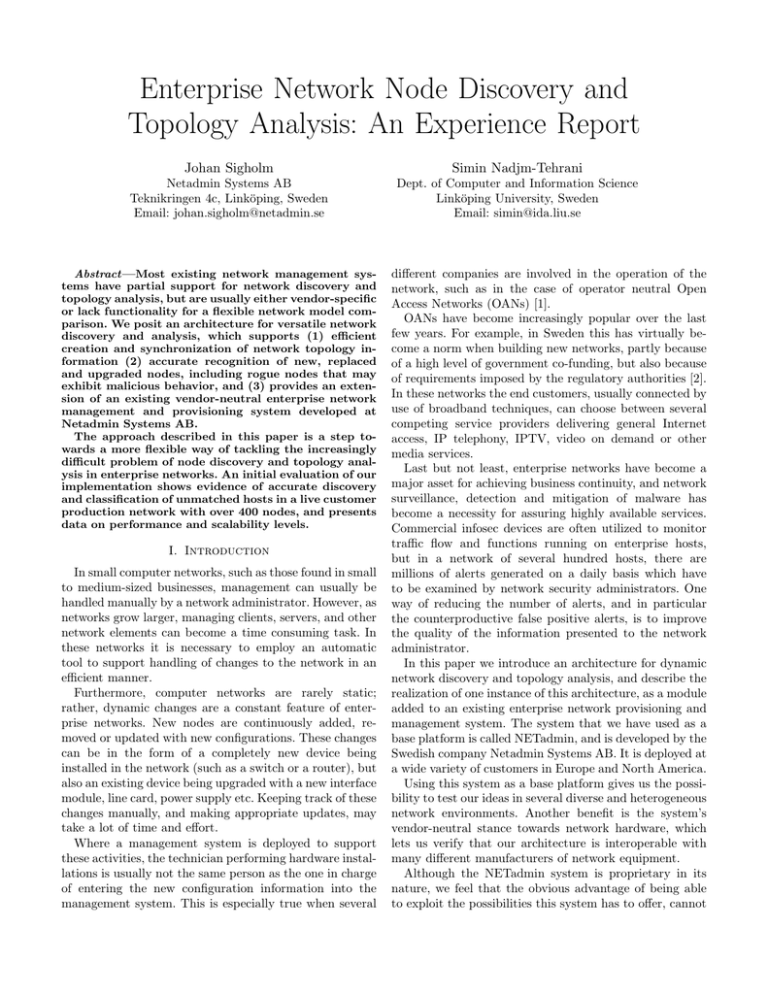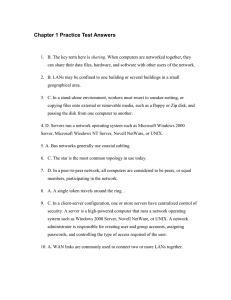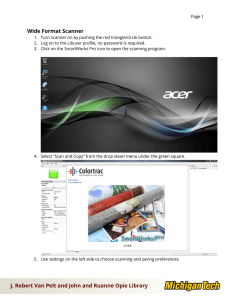Enterprise Network Node Discovery and Topology Analysis: An Experience Report Johan Sigholm
advertisement

Enterprise Network Node Discovery and Topology Analysis: An Experience Report Johan Sigholm Simin Nadjm-Tehrani Netadmin Systems AB Teknikringen 4c, Linköping, Sweden Email: johan.sigholm@netadmin.se Dept. of Computer and Information Science Linköping University, Sweden Email: simin@ida.liu.se Abstract—Most existing network management systems have partial support for network discovery and topology analysis, but are usually either vendor-specific or lack functionality for a flexible network model comparison. We posit an architecture for versatile network discovery and analysis, which supports (1) efficient creation and synchronization of network topology information (2) accurate recognition of new, replaced and upgraded nodes, including rogue nodes that may exhibit malicious behavior, and (3) provides an extension of an existing vendor-neutral enterprise network management and provisioning system developed at Netadmin Systems AB. The approach described in this paper is a step towards a more flexible way of tackling the increasingly difficult problem of node discovery and topology analysis in enterprise networks. An initial evaluation of our implementation shows evidence of accurate discovery and classification of unmatched hosts in a live customer production network with over 400 nodes, and presents data on performance and scalability levels. I. Introduction In small computer networks, such as those found in small to medium-sized businesses, management can usually be handled manually by a network administrator. However, as networks grow larger, managing clients, servers, and other network elements can become a time consuming task. In these networks it is necessary to employ an automatic tool to support handling of changes to the network in an efficient manner. Furthermore, computer networks are rarely static; rather, dynamic changes are a constant feature of enterprise networks. New nodes are continuously added, removed or updated with new configurations. These changes can be in the form of a completely new device being installed in the network (such as a switch or a router), but also an existing device being upgraded with a new interface module, line card, power supply etc. Keeping track of these changes manually, and making appropriate updates, may take a lot of time and effort. Where a management system is deployed to support these activities, the technician performing hardware installations is usually not the same person as the one in charge of entering the new configuration information into the management system. This is especially true when several different companies are involved in the operation of the network, such as in the case of operator neutral Open Access Networks (OANs) [1]. OANs have become increasingly popular over the last few years. For example, in Sweden this has virtually become a norm when building new networks, partly because of a high level of government co-funding, but also because of requirements imposed by the regulatory authorities [2]. In these networks the end customers, usually connected by use of broadband techniques, can choose between several competing service providers delivering general Internet access, IP telephony, IPTV, video on demand or other media services. Last but not least, enterprise networks have become a major asset for achieving business continuity, and network surveillance, detection and mitigation of malware has become a necessity for assuring highly available services. Commercial infosec devices are often utilized to monitor traffic flow and functions running on enterprise hosts, but in a network of several hundred hosts, there are millions of alerts generated on a daily basis which have to be examined by network security administrators. One way of reducing the number of alerts, and in particular the counterproductive false positive alerts, is to improve the quality of the information presented to the network administrator. In this paper we introduce an architecture for dynamic network discovery and topology analysis, and describe the realization of one instance of this architecture, as a module added to an existing enterprise network provisioning and management system. The system that we have used as a base platform is called NETadmin, and is developed by the Swedish company Netadmin Systems AB. It is deployed at a wide variety of customers in Europe and North America. Using this system as a base platform gives us the possibility to test our ideas in several diverse and heterogeneous network environments. Another benefit is the system’s vendor-neutral stance towards network hardware, which lets us verify that our architecture is interoperable with many different manufacturers of network equipment. Although the NETadmin system is proprietary in its nature, we feel that the obvious advantage of being able to exploit the possibilities this system has to offer, cannot be disregarded. The high-level architecture extension we present is certainly applicable to other similar network management and surveillance implementations, and most likely transferable to many different environments, both proprietary and open source. This paper’s main contributions are therefore (i) the defined discovery and analysis methodology, (ii) the network node representation model, and (iii) the definition of problems which need to be solved, by suggested future extensions of the implementation. II. Related work Several research projects have identified the need for a topology agent where information about the hosts, their software patch levels, and known vulnerabilities are correlated to the alerts produced by the infosec devices in order to eliminate or aggregate some alerts [3], or to facilitate software updates [4]. Designing discovery services to aid decision-plane algorithms, maintaining correct semantics during low-level network change and allowing zero preconfiguration has also been identified as an important objective when constructing future network architectures [5]. There have also been projects aimed at designing tools for both vendor dependent and independent topology discovery [6]. The NetMap project [7] provides a solution for the use of a variety of composable network tools, each used for a specific purpose. There are also many available software solutions for network management and security monitoring, both open source projects like Netdisco [8] and Nessus [9], and proprietary solutions like HP OpenView [10] and Microsoft SMS [11]. However, these tools do not supply functionality for precise discrepancy detection or the possibility to practically and efficiently compare two network models in an enterprise environment. III. Network modeling architecture The motivation for the development of this new architecture is to fill the gap in existing network management tools when it comes to flexibility of node representation and network model comparison. Our ambition is to construct a method for network discovery, built on standard tools and protocols, where the nodes’ features are defined in an adaptable manner, which can fit any type of network device, running any software, and also be expandable through future improvements. Additionally we want to be able to exploit the gathered node information to perform a comprehensive topology analysis, where the offline model of the network, stored in the management system’s database, is continuously compared to the real-world network. Discrepancies should be accurately analyzed, evaluated, and presented to the network administrator in a concise fashion as a basis for taking appropriate action. Figure 1 gives a high-level description of our proposed generic architecture. Figure 1. High-level discovery and topology analysis architecture 1) The network administrator configures the network which should be scanned through the User Interface. The request is sent out to a Discovery Agent. 2) The Discovery Agent scans the network and all active nodes, according to the received configuration. A signature is created for each discovered node, containing its characteristics. 3) The signatures are transferred to the Topology Analysis Engine. 4) The information is processed by comparing the live results with the off-line model database. 5) A digest list of conclusions is presented to the network administrator via the User Interface, who can then act upon this information. By using this basic architecture, a high level of flexibility is attained. The network administrator may choose exactly which node information that is of interest, for example IP or MAC addresses, system names, software versions, hardware modules installed or active running services. Standard tools to retrieve this information are implemented at the Discovery Agents. The resulting data is stored in XML signature files, which can be parsed by the Topology Analysis Engine. The main tasks which should be handled effectively by an implementation of this architecture are: • Facilitating the first-time creation of the off-line network model, by automating the discovery process. • Continuous monitoring of changes in the network, which are overlooked due to either a failure of communication between responsible people or by pure negligence. • Detection of unknown, possibly malicious network elements, in order to minimize the inflicted damage. IV. The discovery service extension Our architecture is instantiated through an extension to an existing enterprise network management and provisioning system. Figure 2 shows a simplified schematic view Figure 2. The NETadmin system with proposed extensions of the system, with our added modules as the dotted elements. This design allows implementing the required new functionality while still adhering to the existing structure of a management system. A typical NETadmin installation is comprised of two main Windows 2003 Servers, one handling the access verification and privilege procedures, and the other the logical operations and the main database transactions. A family of NETservers, running a customized version of Debian GNU/Linux, is used to host the back-end management services. The Windows servers act both as a front-end, with graphical user interfaces, and as a logical processing unit that sends out ”work orders” to the various NETservers. The NETservers are assigned specific tasks, such as network hardware configuration, resource provisioning, gathering of statistics and monitoring. Data storage is implemented by use of databases; currently MySQL databases on both Windows and Linux platforms. The main NETadmin database is hosted on the Windows server and contains the main information about the system, settings, customer data etc. The NETservers usually have their own databases, mainly used for temporary storage of collected network data which is to be synchronized with the main database. Communication between the servers is done by either HTTPS connections or by SQL queries. To implement our architecture, a new NETserver is added for the network discovery implementation, which acts as the Discovery Agent. The Topology Analysis Engine is implemented as a ”runner” in the NETadmin domain. Its task is to compare the data collected by the discovery NETserver, and decide if any changes have occurred and if so what exactly has happened. The User Interface is implemented as an extension of the existing NETadmin graphical user interface (GUI). A. Network node discovery The Discovery Agent NETserver consists of three major parts, the networks processor, the network scanner and the host scanner. These are three independent modules, implemented in the PHP scripting language. They are exe- Figure 3. Discovery service UML activity diagram cuted in a sequential top-down fashion where the networks processor spawns instances of the network scanner, which in its own turn spawns instances of the host scanner. This is done in order to achieve the degree of parallelization needed to complete the tasks in a limited time frame. The UML activity diagram in Figure 3 shows the workflow behavior of the Discovery Agent. 1) Networks processor: The networks processor manages the networks which are to be scanned. The information is updated when the network administrator adds or changes settings via the User Interface. Each network is processed to see if it is time to perform a new scan of the current network, based on the user defined update interval. If this is the case, a network scanner process is spawned. 2) Network scanner: The network scanner scans a network, designated by a network address and a netmask, to detect which attached hosts are active. Two major paradigms of network scanning are active and passive scanning, where active scanning tries to detect hosts by active probing [12] and passive scanning listens to detect traffic generated by the hosts [13]. In the current instance of the architecture we have favored active scanning since the devices we primarily want to detect (i.e. switches, routers etc.) very seldom generate any unprovoked traffic. The scanning is performed by sending out data on the network targeted at the address which you want to detect. What kind of data to send may vary, but a common and straightforward approach is to send an ICMP (Internet Control Message Protocol) ECHO request. A performance evaluation showed that using the program Nmap (Network Mapper) [14], which is a free open source utility for Table I XML signature for a discovered host <?xml version="1.0" encoding="ISO-8859-1"?> <signature> <sysdescr>Summit1iTx - Version 7.4.2 (Build 6)</sysdescr> <sysname>core-sw-01</sysname> <syslocation>server room 3</syslocation> <syscontact>support@extremenetworks.com</syscontact> <sysobjectid>.1.3.6.1.4.1.1916.2.14</sysobjectid> </signature> network exploration and security auditing, was the most efficient of the available scanning methods. After a complete scan of a particular network, the list of detected active hosts is processed to establish which hosts are new and which have been seen before. This is determined by a combination of IP address, MAC address and a status flag in the database. Thus, a host which was previously inactive (e.g. turned off for a period of time), is considered new if it becomes active again. All new hosts are then further examined individually by the host scanner script. 3) Host scanner: This module performs the information gathering from the individual active hosts discovered by the network scanner. The main protocol used is the Simple Network Management Protocol (SNMP), which is implemented in most manageable network equipment. More information about the hosts (e.g. available services or running operating system) can also be retrieved by using either Nmap, or more specialized tools such as Xprobe [15]. To be able to read information from the nodes via SNMP, an SNMP community string is required, which serves as a password for access control. The community strings to be tried are provided by the NETadmin server. They are ultimately based on information entered by the system administrator when configuring the system. In order to optimize the scan speed, a working SNMP community, if found, is stored in the host entry to be tried first the next time. In the basic setting, some standard SNMP information is gathered from the host: ”system description”, ”system name”, ”system location”, ”system contact” and ”system object ID”. Which information that is gathered can however be dynamically configured. Based on this information, a compound XML host signature is generated (see Table 1) and stored in the database for use by the later analysis process by the Topology Analysis Engine. B. Topology analysis The Topology Analysis Engine is a program which retrieves and processes the data collected by the Discovery Agent, and stores any detected discrepancies. The program is implemented as a solution in Microsoft Visual Basic .NET, with the main functions in a dynamic linked library (DLL) available to the rest of the system as a COM+ component. In the course of the analysis process, the program compares the off-line model of the network which exists in the NETadmin internal database with the real-world data gathered by the discovery NETserver. This is done through evaluation of numerous different parameters. Exactly which parameters are considered is fully configurable by the system user. An example of this can be running software version, installed hardware components, or unit serial number. Unknown discovered hosts, which do not previously exist in the NETadmin database, can still be identified to a certain degree. This is done by a set of user-defined rules and conditions, where a rule is built up of a number of conditions. Each condition is formulated as a regular expression [16], and if all conditions belonging to a certain rule evaluate to ”true”, the rule is matched. The rule can then point to certain a type of unit, a vendor or similar characteristic. In this way the user can be given detailed information about the unit, which may be of assistance when deciding if the unit is legitimate. Configuration of the discovery system is done through an extension of the existing NETadmin graphical user interface. This is a web-based environment, with Microsoft Internet Information Services (IIS) serving Active Server Pages (ASP) over secure HTTP (HTTPS). The access control is based on a tiered system, where the network owner, service providers and customer service have separate views. V. Evaluation The implemented system has been tested in two ways. First, we present the tests performed in a special testbed at Netadmin Systems (the staging environment) and the live testing at a customer site. Next, we explain how performance tests were carried out in a controlled environment for measuring the overhead and average response time of the discovery service. A. Live tests A complete testing of the discovery system was performed in a real-world environment at a customer company. The company is a regional energy company active in the southwest of Sweden, and operates a metropolitan area network consisting of about 400 active core nodes. Prior to this test, some preliminary tests were performed in the so-called staging environment; a copy of the live system, on which new functionality can be installed and tested to verify that it does not conflict with existing components. If any problems arise they can be dealt with, and the system may be rebooted or even completely reinstalled, without any customers being affected. These environments are hosted on servers at Netadmin Systems, and are realized by VMware virtualization software. They do not have any contact with the outside world, but are periodically synchronized with the live systems to keep them up to date with settings and customer data. The tests were used to ensure that no database connections were accidentally left open and that there was no evidence of memory leaks. For the live tests, two test networks at the same company were selected, containing a total of 190 known hosts. The scanning of the networks was successful and the discovery system was able to identify all known hosts in the two networks. A total of 226 discrepancies were found. 79 of these were conflicting system names, where a slightly different naming convention had been used on the physical hosts compared to the one used in the NETadmin system. 143 were conflicting MAC addresses, mainly due to missing MAC address entries in NETadmin system for a majority of the hosts. On top of this, four new, previously undocumented hosts were discovered. These could be identified by the Topology Analysis Engine, by rules matching the object identifier string (sysObjectID) in the XML signature, as four battery backup units (UPSs). They had apparently been installed by technicians a few months earlier, but had never been properly documented in the NETadmin system, which had led to them subsequently being forgotten. They could however now easily be identified and synchronized into the off-line network model. B. Performance tests Preliminary experiments on the discovery service showed that the time required for one scan of a certain network varied greatly depending on the chosen approach. There was also a substantial difference in utilization of system resources depending on the degree of parallelization. Different methods were evaluated to determine the key criteria for scalability, which were identified as CPU resources and database connections. Bandwidth usage by the discovery scans was found to be negligible in all of the evaluated scanning methods. To begin with, a simple top-down solution was tested as a baseline. This method processed all discovered active nodes in the network one by one. Obviously, this was painfully slow and would not scale well with the gradual increase in size of the networks. Next, the Discovery Agent was divided into smaller parts which could be executed simultaneously. Three distinct activities were identified which could be separated into parallelizable processes. The parallel scanning approach showed a dramatic improvement in scan speed, but also an excessive consumption of system resources; mainly concerning CPU usage and database connections. This became an issue when executing the scripts in a shared environment. Finally, a few different scheduling methods were evaluated to control the resource utilization. One way was to implement the scheduling as a function in the scripts themselves. However, this proved to be quite crude for limiting CPU usage. The best result was achieved by making use of the Linux kernel process scheduling subsystem [17], giving Figure 4. CPU load during discovery scans the scan processes a slightly lower priority than normal. The database connection management was implemented directly in the script, with a user configurable minimum amount of connections, or fraction of the available connections, to be reserved for other applications. In this way the networks could be scanned rapidly while still leaving room for other services to execute in the same environment. In order to evaluate the performance of the different approaches above, a special testing environment was prepared. In this environment the scanning scripts and the statistics gathering tool were the only resource consuming processes running. The NETserver hardware1 , size of the network and number of active nodes (254) were constant between the three runs. Figure 4 illustrates the CPU load while performing the scans and how long each scan took. In the first case a sequential scan was performed, which took 19 minutes and 40 seconds and generated a fairly even load. The time Ts required to scan a network with n active nodes, using this sequential approach, can be expressed by Ts = n X ti i=1 where ti is the time to scan the individual node i. The second graph in figure 4 shows the parallel scan without scheduling, which took a mere 26 seconds, but consumed all available CPU resources. Given unlimited resources, the time Tp to scan a network using this parallel approach, can be expressed by Tp = tmax 1 Intel Core Solo T1350 CPU @ 1.86 GHz, 512 MB RAM where tmax is the time to scan the node which takes the longest, since all nodes are scanned simultaneously. The bottom graph in figure 4 illustrates the effects of the resource scheduler with some specific settings. Peaks of heavy processor usage occur until the limit of maximum allowed database connections is reached, and the process has to wait until new connections are freed. A scan using this method took 2 minutes and 34 seconds with the chosen settings. These performance tests are not by themselves conclusive, but along with the presented analytical rationale they serve as an indication that our implementation can handle scalability issues, and demonstrates that it provides a mechanism for regulating system resource consumption in a shared environment. VI. Current work The architecture we have presented is not static, but can be further developed with functions for additional reliability, usability and performance. Currently, the focus lies on work which expands the topological model of the network and increases the degree of rogue node detection. • • • • By probing network elements for their connections to other nodes, using their respective forwarding information base (FIB) and a variety of different discovery protocols, a more comprehensive model of the network can be generated. This allows for discovery of both nodes and vertices in the network graph. Supplementing the Discovery Agent with a passive scanning engine makes it possible to detect rogue nodes more efficiently, especially those who do not react to active scanning stimuli. Collection of DHCP traffic, by use of techniques such as DHCP snooping and the DHCP Option 82, can give further information about hosts entering the network. Increasing the support for vendor-specific hardware drivers improves the possibility to better identify certain network equipment and to collect detailed data and statistics. VII. Conclusions We have presented an architecture for effective and flexible network node discovery and topology analysis. Implemented as an add-on module to an existing network management system, it has demonstrated the benefit of synchronization between off-line data and real-world network topology. Using XML and regular expressions to define and evaluate parameters and conditions makes the system highly adaptable and scalable for future improvements. This work thus lays the ground for further extensions in a security-aware enterprise network management and monitoring system. Adding further data, e.g. about current system versions or patch levels, is a straightforward process and prepares for automatic vulnerability assessment of the nodes in an enterprise network. Future work includes the combination of such a service with a risk analysis and threat assessment infrastructure for business-critical systems. References [1] Battiti R., Lo Cigno R. A., Orava F., Pehrson B., ”Global growth of open access networks: from warchalking and connection sharing to sustainable business.” In Proc. 1st ACM WMASH Workshop. September 2003. [2] The National Post and Telecom Agency (PTS), ”IT infrastructure for town and country.” SOU 2000:111. ISBN 91-38-21347-8. November 2000. [3] Gamez D., Nadjm-Tehrani S., Bigham J., Balducelli C., Chyssler T., Burbeck K., ”Safeguarding Critical Infrastructures.” Chapter in H. B. Diab, A.Y. Zomaya (Eds.), Dependable Computing Systems: Paradigms, Performance Issues and Applications. John Wiley & Sons, Inc. ISBN 0-471-69461-4. November 2005. [4] Han C.C., Kumar R., Shea R., Srivastava M., ”Sensor network software update management: a survey.” In Proc. ACM International Journal on Network Management. Vol. 15. July 2005. [5] Greenberg, A., Hjalmtysson, G., Maltz, D. A., et al., ”A clean slate 4D approach to network control and management.” ACM SIGCOMM Computer Communications Review. October 2005. [6] Barthel A., ”Analysis, Implementation and Enhancement of Vendor dependent and independent Layer-2 Network Topology Discovery.” Diploma Thesis, Chemnitz University of Technology, Chemnitz, Germany, April 2005. [7] Vigna G., Valeur F., Zhou J., Kemmerer R.A., ”Composable Tools For Network Discovery and Security Analysis.” In Proc. Annual Computer Security Applications Conference (ACSAC). December 2002. [8] Netdisco. http://netdisco.org/. [9] Tenable Network Security, Nessus Open Source Vulnerability Scanner Project. http://www.nessus.org/. [10] HP OpenView, http://www.openview.hp.com/. [11] Microsoft Systems Management Server. http://www.microsoft.com/smserver/. [12] Shankar U., Paxon V., ”Active Mapping: Resisting NIDS Evasion Without Altering Traffic.” In Proc. 2003 IEEE Symposium on Security and Privacy. May 2003. [13] Thomas, Y., Debar, H., Morin, B., ”Improving security management through passive network observation.” In Proc. First International Conference on Availability, Reliability and Security, ARES 2006. April, 2006. [14] Nmap. http://insecure.org/nmap/. [15] Xprobe2, ”Active OS fingerprinting tool.” http://xprobe.sourceforge.net/. [16] Friedl, J., ”Mastering Regular Expressions, 3rd Edition”. O’Reilly Media Inc. ISBN 0-596-00289-0. August 2006. [17] Bovet D. P., Cesati M., ”Understanding the Linux Kernel, 3rd Edition.” O’Reilly Media Inc. ISBN 0-596-00565-2. November 2005.



